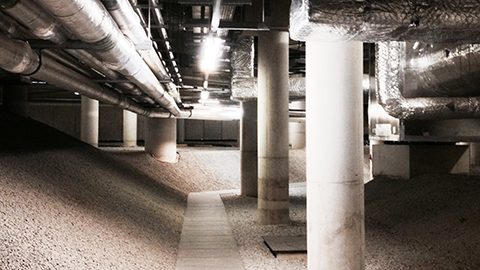Bridgewater Hall public building tours (a number BSL interpreted) and specialist organ tours run regularly throughout the year. See a full list of tour dates at the link below, tickets can be booked online or via the Box Office.
If you’re interested in booking a private tour for your group, please contact the Box Office claire.hanson@bridgewater-hall.co.uk or call 0161 907 9010.
A Tour of the Hall - Discover its Secrets and Stories


Built 26 years ago, The Bridgewater Hall has become a cultural landmark in Manchester – but it’s also a building filled with hidden features and surprising facts.
Have you ever looked under the folding seats in The Bridgewater Hall’s auditorium? If you do, you’ll discover a number of unusual, oblong holes. They are cut out of the wooden bases, so that the fabric of the cushion above is visible. The reason for their existence has to do with the Hall’s acoustics – the meticulously balanced facets of the space that affect the way sound transmits. In order to work out their purpose, you have to think about how much noise 2,355 seated people might absorb from a performance, the fact that the exposed underside of the padded cushion faces the stage when the seats are unoccupied, and the reality that staff have to do sound tests earlier in the day, when the auditorium is empty.
It’s this level of careful planning that makes The Bridgewater Hall, a building where even the glass is treated with a self-cleaning chemical, so remarkable. Examine almost any aspect of the architecture, and there’s a story behind it. The pointed prow of the roof above the main entrance, for example: you can trace a line from its tip to Manchester Town Hall’s clock tower. It’s a trajectory that connects the building with Manchester’s administrative centre, so that the position of the Hall at an angle to Lower Mosley Street is no accident.
What makes this attention to detail all the more extraordinary is the fact that the building was delivered under budget. The entire project cost £42m, a relatively small sum compared to the figures spent on similar buildings today, with the balance of the money given over to specially-commissioned works of art. These include the Carrara marble installation by Kan Yasuda in Barbirolli Square at the main entrance. If you’ve ever wondered what the sculpture affectionately nicknamed ‘the pebble’ by locals is really called, its proper title is the Ishinki Touchstone – so named because it’s meant to bring luck to those who touch it. Used by children as an obstacle to climb, the installation embodies the friendly aspirations of the building.
There’s a place in the ground floor foyer where the view makes this goal obvious. It’s a spot few people will have stood in, where it’s possible to look up and see how the generous foyers on the floors above create a set of social terraces that wrap around the auditorium. Even the metal for the doors to the auditorium was chosen so that it might act as a record of everyone who passes through them; one of the properties of bronze is that it retains subtle marks when you put a hand to it. Go to see a performance – whether it be comedy, classical music, kitchen discos or jazz – and you too will become a part of The Bridgewater Hall.
When you do visit, it’s worth remembering that the 22,500 ton construction you’re standing in has no rigid contact with its foundations. Instead, the whole concrete structure is supported by earthquake-proof isolation bearings, or giant springs, so that the performance space is isolated from any external vibrations that might mar the acoustics.
Instead, it’s possible to engineer the echo in the auditorium so that it’s exactly 2.2 seconds long, the ideal reverberation for a symphony orchestra. It’s also possible to make sure that the sound from The Bridgewater Hall’s £1.2m Marcussen pipe organ, installed at the back of the stage, reaches the audience at the same time as the notes from the lead vocalist or violin. A tour inside the instrument, which took three years to design and build, demonstrates just how remarkable this is: the handcrafted wooden carcasse contains 5,500 pipes that range from a few millimetres to nearly ten metres long. It’s not until you actually sit in the space and listen to a tour guide, sound test or production that you truly get a sense of how special the acoustics in the auditorium really are.
It’s also close to impossible to describe what it’s like to climb down actually beneath the building and explore the undercroft on a public building tour. As you descend the stairs, there’s a noticeable change in the atmosphere – the sound deadens, interrupted only by the hum of service pipes. You’re faced with a grey moonscape, dotted with the concrete pillars that support the auditorium above. You can see the earthquake bearings through the clear sides of the green boxes they’re housed in. Normally off limits to the public, it’s an experience like no other.
By Polly Checkland Harding
